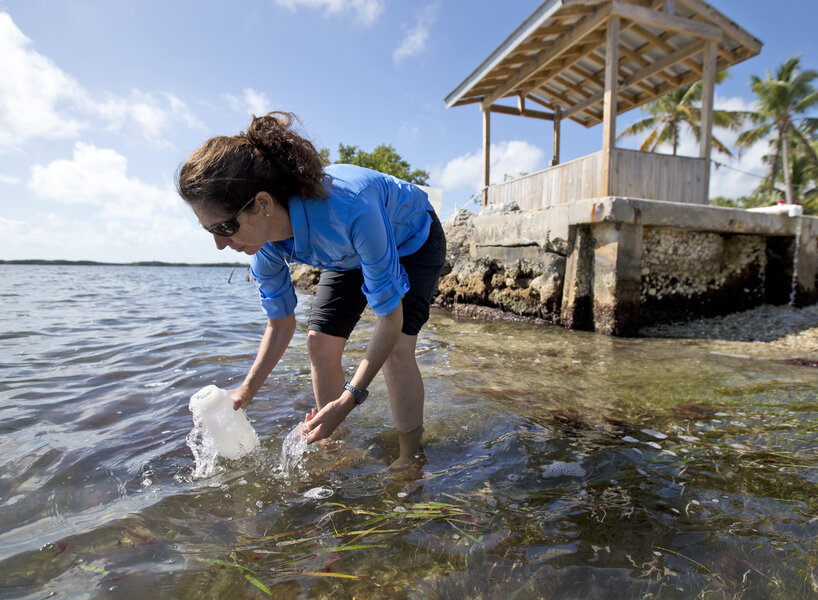How the world made macro strides in curbing microbeads
Loading...
When it comes to eliminating plastic waste, a great deal of progress is being made at the smallest of levels: microbeads.
Used as exfoliators in such personal care products as face washes and shower gels, these tiny plastic spheres often end up in waterways and oceans, with the potential to pass toxins to fish and humans. Microbeads are so small they can’t be filtered out of the water system once washed down the drain.
But in recent years there has been a growing effort to ban these beads from manufacture and import. In the United States, the Microbead-Free Waters Act was signed into law in 2015. The law bans microbeads in the US in incremental stages, starting with outlawing the manufacture of microbeads in cosmetics in July 2017, with full implementation of the law in 2019.
“We saw pretty swift action taken at the national level by Congress to pass ... [the] legislation, and we’re seeing similar legislation efforts elsewhere around the world,” says Nick Mallos, director of the Trash Free Seas program at Ocean Conservancy, an environmental advocacy nonprofit based in Washington, D.C.
Launched in January, Britain’s ban, which includes biodegradable plastics, is lauded as “the strongest and most comprehensive ban to be enacted in the world,” according to Sue Kinsey, senior pollution policy officer at the Marine Conservation Society in Herefordshire, England. Canada, too, implemented the first stage of its ban early this year. New Zealand’s ban will go into effect in June.
Microbeads, which the US law defines as plastic particles 5 millimeters or smaller in size, contribute to the much larger issue of plastic waste entering the ocean. Eight million to 10 million metric tons (8.8 million to 11 million tons) of plastic waste are dumped into the ocean annually. By 2050, there could be more plastic by weight in the ocean than fish, according to a report by the World Economic Forum.
Prior to the US ban, an estimated 3 trillion microbeads were released into the environment each year. And when microbeads enter waterways and oceans, they can have a devastating effect as they soak up toxins and are eaten by fish.
“[Microbeads] are like little tiny sponges. They can suck up any pesticides or flame retardants,” says Rachel Sarnoff, executive director of 5 Gyres, a nonprofit organization in Los Angeles that focuses on reducing plastics pollution. As a result, microbeads become a million times more toxic than the surrounding water.
Mistaking them for fish eggs, marine life often eat these tiny, toxic particles. Ingesting plastic isn’t a problem just for fish, says Mr. Mallos. “Plastics have infiltrated every level of the marine food web, and of course, humans are at the top of the marine food web, so there is some question about the potential risk to humans as a result of the contamination of plastics in the marine environment.”
The negative environmental effect of microbeads first gained attention in 2013 after a report by 5 Gyres and the State University of New York at Fredonia revealed a high concentration of the plastics had infiltrated the Great Lakes. In response, Illinois became the first state to pass legislation against microbeads. The plastic pollution issue struck a chord with the public, notes Jennifer Walling, executive director of the Illinois Environmental Council.
“Illinois is rarely a state that steps up on environmental issues first, but Illinoisans care deeply about Lake Michigan and the Great Lakes,” says Ms. Walling in an email.
Lawmakers aren’t the only ones taking action. Once microbeads were identified as a problem, some manufacturers began to voluntarily discontinue their use in various products. In 2013, Johnson & Johnson committed to phase out microbeads from its products worldwide. Unilever pulled microbeads from exfoliating products in 2014, exchanging them for natural alternatives such as walnut shells and cornmeal.
Researchers are hopeful that the quick action in banning microbeads will pave the way for banning other plastic items that could easily be replaced with biodegradable options.
“We would argue that it’s the same thing for plastic straws, plastic cups, plastic coffee lids.... If we can show that these items are clearly contributing to this issue, then I think we can gain some more,” says Ms. Sarnoff.






